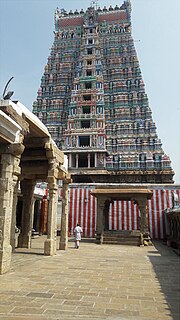 W
WKalugasalamoorthy Temple in Kalugumalai, a panchayat town in Thoothukudi district in the South Indian state of Tamil Nadu, is dedicated to the Hindu god Murugan. Constructed in the Dravidian style of architecture, the temple is believed to have been expanded during the 18th century with the images excavated from Kalugumalai. The core temple has a rock-cut architecture exemplary of early Pandyan Art. The other portions of Kalugumalai houses the 8th century Kalugumalai Jain Beds and Vettuvan Koil, an unfinished Shiva temple.
 W
WKalugumalai Jain beds in Kalugumalai, a panchayat town in Thoothukudi district in the South Indian state of Tamil Nadu, are dedicated to the Jain and Hindu religious figures. Constructed in rock cut architecture, the unfinished temple is believed to have been built during the reign of Pandyan king Parantaka Nedunjadaiya. The rock-cut architecture at Kalugumalai is an exemplary specimen of Pandyan art. The other portions of Kalugumalai houses the 8th century unfinished Shiva temple, Vettuvan Koil and Kalugasalamoorthy Temple, a Murugan temple at the foothills.
 W
WNellaiappar Temple is a Hindu temple dedicated to the deity Shiva, located in Tirunelveli, a city in the South Indian state of Tamil Nadu. Shiva is worshipped as Nellaiappar represented by the lingam and his consort Parvati is depicted as Kanthimathi Amman. The temple is located on the northern banks of Thamirabarani River in Tirunelveli district. The presiding deity is revered in the 7th century Tamil Saiva canonical work, the Tevaram, written by Tamil saint poets known as the nayanmars and classified as Paadal Petra Sthalam.
 W
WThe Pandya dynasty, also known as the Pandyas of Madurai, was a dynasty of south India, one of the three ethnically Tamil lineages, the other two being the Chola and the Chera. The rulers of the three dynasties were referred to as "the three crowned rulers of the Tamil country". The Pandyas ruled extensive territories, at times including the large portions of present-day south India and Sri Lanka. Madurai was capital of the pandya kingdom.
 W
WRock cut and structural temples are significant part of Pandyan art and architecture. The vimana and mandapa are some of the features of the early Pandyan temples. Groups of small temples are seen at Tiruchirappalli district of Tamil Nadu. The Shiva temples have a Nandi bull sculpture in front of the maha mandapa. In the later stages of Pandyas rule, finely sculptured idols, gopurams on the vimanas were developed. Gopurams are the rectangular entrance and portals of the temples.
 W
WSrivilliputhur Andal Temple in Srivilliputhur, a town in Virudhunagar district in the South Indian state of Tamil Nadu, is dedicated to the Hindu god Vishnu. It is located 80 km from Madurai. Constructed in the Dravidian style of architecture, the temple is glorified in the Divya Prabandha, the early medieval Tamil canon of the Azhwar saints from the 6th–9th centuries AD. It is one of the 108 Divyadesam dedicated to Vishnu, who is worshipped as Vatapatrasayi and his consort Lakshmi as Andal. It is believed to be the birthplace of two of the Azhwars, namely Periyalvar and his foster daughter Andal.
 W
WThe Velvikudi inscription is an 8th-century bilingual copper-plate grant from the Pandya kingdom of southern India. Inscribed in Sanskrit and Tamil languages, it records the renewal of a grant of the Velvikudi village to a brahmana by the Pandya king Nedunjadaiyan Varaguna-varman I alias Jatila Parantaka in c. 769-770 CE.